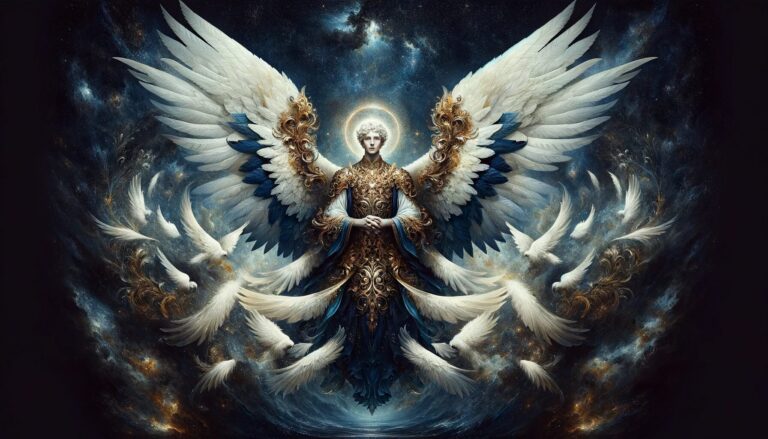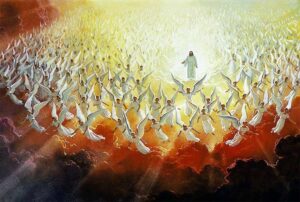Table of Contents
Few entities evoke as much intrigue, controversy, and mystique as Gadreel in the vast tapestry of mythical beings that spans across cultures and time. This enigmatic figure exemplifies a character shrouded in both darkness and redemption, embodying the complexities of human existence and the blurred line between good and evil.
Origins and Family
The origins of Gadreel trace back to Judeo-Christian tradition, specifically to the Hebrew Bible. In this tradition, people often identify Gadreel as one of the fallen angels, and his story intertwines with the narrative of the rebellious angels who defied God’s will. Some interpretations suggest that Gadreel was among the angels who fell from grace when they followed Lucifer, also known as Satan, in his rebellion against God. In this context, other fallen angels, including some of the most notorious figures in Christian demonology, comprise Gadreel’s family.
Appearance
Descriptions of Gadreel’s appearance vary, as the biblical accounts provide little detail. However, he is generally depicted as a celestial being with an angelic appearance. In some depictions, Gadreel may have wings and a radiant countenance, reminiscent of traditional angels. This appearance serves as a paradox, as it conceals the darkness and turmoil within him, making him a compelling and contradictory figure in mythology.
Abilities

Gadreel’s abilities are rooted in his angelic nature, which grants him a range of powers. These powers often include:
Flight: Like other angels, Gadreel possesses the ability to fly, enabling him to move freely between the realms of heaven and earth.
Healing: Some legends attribute healing abilities to Gadreel, suggesting that he can mend wounds and alleviate suffering.
Knowledge: Being an angel, Gadreel often associates with knowledge and wisdom, making him a source of enlightenment and guidance.
Communication: He can communicate with both humans and other celestial beings, serving as a messenger between realms.
Weaknesses
Despite his celestial powers, Gadreel is not invulnerable. His weaknesses are largely rooted in his internal struggles and moral conflicts. Some of his weaknesses include:
Inner Turmoil: Gadreel’s inner turmoil and guilt over his role in the rebellion against God weigh heavily on him, making him vulnerable to emotional manipulation.
Redemption: Those who wish to manipulate him can exploit Gadreel’s desire for redemption and the opportunity to regain God’s favor.
Mortal Form: When Gadreel takes on a mortal form, he becomes subject to the same limitations and vulnerabilities as humans, including aging and mortality.
Behavior with Humans
Gadreel’s interactions with humans are a central theme in many stories and interpretations.While people often associate him with the fallen angels who brought about humanity’s downfall, there are also accounts of him seeking redemption and assisting humans. His behavior towards humans can be summarized in two distinct aspects:
Deception and Temptation: In some versions of the story, Gadreel portrays the serpent who tempts Eve in the Garden of Eden, leading to the original sin. This portrayal casts him in a negative light, as a deceiver and corrupter of humanity.
Redemption and Guidance: Alternatively, some depict Gadreel as an angel who seeks redemption and offers guidance to humans on their spiritual journey. In these narratives, he seeks to undo the harm he caused and guide humanity towards the path of righteousness.
Symbols Representing Gadreel
The symbols deeply intertwine with Gadreel’s dual nature as a fallen angel seeking redemption. Common symbols include:
Serpent: The serpent is a potent symbol associated with Gadreel’s role in the temptation of Eve. It represents the duality of his character and the consequences of his actions.
Wings: Angelic wings symbolize his celestial origins and his potential for redemption and transformation.
Light and Darkness: The interplay between light and darkness serves as a powerful symbol of Gadreel’s struggle between his angelic nature and his past transgressions.
Related Myths and Stories
The myth of Gadreel is often intertwined with other biblical narratives and figures, adding depth and complexity to his character. Some related myths and stories include:
The Fall of Lucifer

In the beginning, Lucifer, the most radiant of angels, harbored ambitions of surpassing God’s glory. However, discontent brewed within him, fueling a rebellion against the Creator. Gadreel, once a trusted angelic servant, found himself torn between his loyalty to Lucifer and his allegiance to God. As the rebellion gained momentum, Lucifer’s charismatic rhetoric swayed many angels to join his cause.
Gadreel, caught in this celestial power struggle, eventually made a fateful choice to side with Lucifer. This decision marked a profound betrayal of his heavenly duties and his bond with the divine. As the rebellion reached its climax, God expelled Lucifer and his followers from Heaven, casting them down to the depths of Hell. Gadreel, once an esteemed angel, was now trapped in a realm of eternal darkness and torment, forced to bear the consequences of his defiance.
The Garden of Eden
The Garden of Eden, a tale steeped in symbolism and theological significance, revolves around Gadreel’s pivotal role and the enduring debate surrounding the temptation of Adam and Eve. Additionally, in the idyllic paradise created by God, Adam and Eve thrived, blissfully unaware of sin. Furthermore, amidst this serenity, Gadreel, entrusted with guarding the sacred garden, found himself ensnared by the wily serpent, Lucifer.
As Lucifer’s cunning words wove a web of doubt and curiosity, Gadreel faced a moral dilemma. Should he adhere to his divine duty or succumb to the allure of rebellion?
Moreover, misplaced sympathy for Lucifer’s cause drove Gadreel to yield, resulting in the consumption of the forbidden fruit.
Additionally, this act had profound consequences. Adam and Eve’s innocence shattered, leading to their expulsion from Eden, forever marked by the knowledge of sin. Furthermore, Gadreel also faced divine retribution, as he was banished from Heaven and burdened with the guilt of his betrayal.
The story of Gadreel in the Garden of Eden remains a potent reminder of the complexities of free will, temptation, and the enduring consequences of choices. Furthermore, it continues to spark theological discussions and serves as a cautionary tale about the perils of straying from divine obedience.
The Book of Enoch
In the apocryphal Book of Enoch, Gadreel emerges as a prominent figure among the fallen angels, shedding light on his role and significance within the myth. Moreover, the text describes Gadreel as one of the Grigori, a group of angels who descend from heaven to cohabitate with mortal women, ultimately leading humanity astray.
Furthermore, Gadreel’s presence in the Book of Enoch underscores his pivotal role in the angelic rebellion, as he succumbs to temptation and rebels against the divine order. Additionally, this narrative offers a deeper understanding of his character, portraying him as an angel who succumbs to earthly desires, particularly the allure of human women.
As a result, as the story unfolds, Gadreel’s actions contribute to the corruption of humanity, teaching forbidden knowledge and introducing sinful practices. His transgressions stand as a stark contrast to his original divine purpose, symbolizing the consequences of angelic disobedience.
Redemption and Transformation
Gadreel’s quest for redemption is a pervasive motif in numerous religious and literary narratives, echoing humanity’s enduring yearning for forgiveness and personal transformation. Furthermore, throughout these tales, Gadreel embarks on a path of self-discovery and spiritual growth, exemplifying the profound potential for change within the human soul.
In addition, in these narratives, Gadreel grapples with the weight of his past transgressions, acknowledging the consequences of his actions and the harm he caused. Moreover, driven by remorse and a deep longing to mend his fractured relationship with the divine, he sets forth on a transformative journey.
Furthermore, his pursuit of redemption often involves undergoing rigorous trials and challenges, testing his commitment to change and his dedication to righteousness. Additionally, along the way, he encounters mentors, spiritual guides, and fellow seekers who assist him in his quest.
As a result, as Gadreel progresses on his redemptive path, his character undergoes a profound transformation. Finally, he sheds his former identity as a fallen angel and emerges as a symbol of hope and renewal. Through acts of selflessness, repentance, and unwavering faith, he ultimately finds the redemption he seeks, thus mending the rift between himself and the divine.
Similar Creatures
Other fallen angels and celestial beings with similar characteristics and themes exist in Judeo-Christian mythology, including:
Lucifer, the leader of the fallen angels, shares similar origins with Gadreel and often receives portrayals as the embodiment of evil and temptation.
Azazel: Various texts mention Azazel as another fallen angel, associated with corruption and the imparting of forbidden knowledge to humans.
Iblis: In Islamic tradition, Iblis is the equivalent of Satan and plays a role in the story of the fall of humanity.
FAQ
What is Gadreel's role in the Garden of Eden story?
In some interpretations, Gadreel is believed to be the serpent that tempts Eve to eat the forbidden fruit, leading to humanity's fall from grace.
Is Gadreel always depicted as a negative character?
No, there are also interpretations where Gadreel seeks redemption and assists humans, making his character more complex.
What are some common symbols associated with Gadreel?
Common symbols include the serpent, wings, and the interplay between light and darkness, representing his duality and struggle.
Does Gadreel appear in other religious texts or myths?
Gadreel is mentioned in various religious texts and apocryphal writings, often with variations in his character and role.
What is the significance of Gadreel in religious discussions?
Gadreel's story raises questions about free will, temptation, and the consequences of choices, making him a topic of theological debate and reflection.




